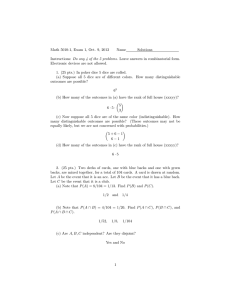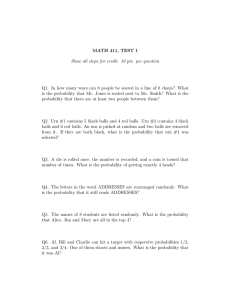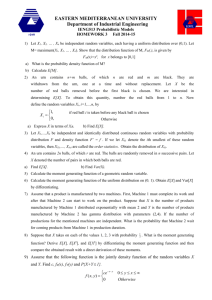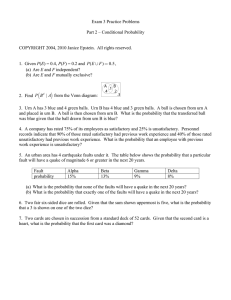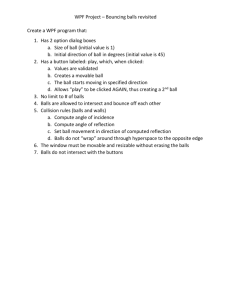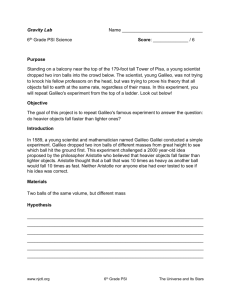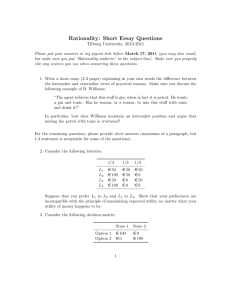Tutorial sheet 1
advertisement
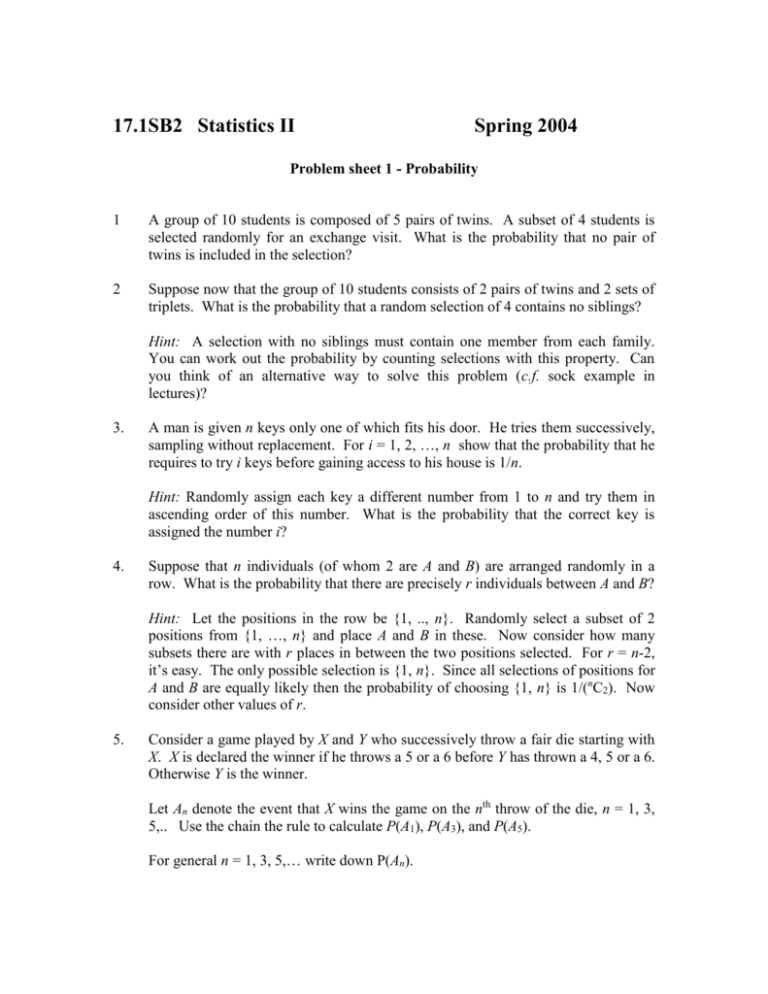
17.1SB2 Statistics II
Spring 2004
Problem sheet 1 - Probability
1
A group of 10 students is composed of 5 pairs of twins. A subset of 4 students is
selected randomly for an exchange visit. What is the probability that no pair of
twins is included in the selection?
2
Suppose now that the group of 10 students consists of 2 pairs of twins and 2 sets of
triplets. What is the probability that a random selection of 4 contains no siblings?
Hint: A selection with no siblings must contain one member from each family.
You can work out the probability by counting selections with this property. Can
you think of an alternative way to solve this problem (c.f. sock example in
lectures)?
3.
A man is given n keys only one of which fits his door. He tries them successively,
sampling without replacement. For i = 1, 2, …, n show that the probability that he
requires to try i keys before gaining access to his house is 1/n.
Hint: Randomly assign each key a different number from 1 to n and try them in
ascending order of this number. What is the probability that the correct key is
assigned the number i?
4.
Suppose that n individuals (of whom 2 are A and B) are arranged randomly in a
row. What is the probability that there are precisely r individuals between A and B?
Hint: Let the positions in the row be {1, .., n}. Randomly select a subset of 2
positions from {1, …, n} and place A and B in these. Now consider how many
subsets there are with r places in between the two positions selected. For r = n-2,
it’s easy. The only possible selection is {1, n}. Since all selections of positions for
A and B are equally likely then the probability of choosing {1, n} is 1/(nC2). Now
consider other values of r.
5.
Consider a game played by X and Y who successively throw a fair die starting with
X. X is declared the winner if he throws a 5 or a 6 before Y has thrown a 4, 5 or a 6.
Otherwise Y is the winner.
Let An denote the event that X wins the game on the nth throw of the die, n = 1, 3,
5,.. Use the chain the rule to calculate P(A1), P(A3), and P(A5).
For general n = 1, 3, 5,… write down P(An).
By noting that the events {An : n = 1, 3, 5,… } form a partition of the event “X
wins”, express the P(X wins) as the sum of a geometric series. Hence, calculate
P(“X wins”). Do you think the game is fair?
6.
(Very difficult!) Polya’s urn. (This procedure is also described in lectures.) Take
an urn initially containing 1 black ball and 1 white ball and consider the following
procedure.
i)
ii)
Remove a randomly chosen ball.
Replace it and add an additional ball of the same colour to the urn.
You repeat this procedure n times so that the urn contains n+2 balls of which r are
white, where r {1, 2, …, n+1}. Show that P(r) is independent of r and, hence,
is equal to 1/(n+1).
Hints: This can be proved by induction. It’s obviously true for n = 0 (i.e. at the
start there is 1 white ball with probability 1). Now assume it’s true for n = k (we
call this assumption the induction hypothesis) and show that it must also be true
for n = k + 1. Note that if you have r white balls in the urn after k+1 repetitions
then either:
a) you had r white balls after k repetitions and drew a black ball on the (k+1)th; or
b) you had r-1 white balls after k repetitions and drew a white ball on the (k+1)th.
The probabilities of a) and b) can be calculated using the induction hypothesis and
the chain rule, and added to give P(r).
The problem can also be solved without using induction using the following
approach. If you have r white balls after n repetitions then you must have r-1
whites and n – r + 1 blacks in your sequence of n draws. How many such
sequences are there? What is the probability of each?
7.
(Tricky, unless you spot the easy way!) A game played by X and Y involves
tossing a fair coin repeatedly and noting the sequence of outcomes. X wins if the
sequence “HHH” arises before the sequence “THH”. Otherwise Y wins. What is
the probability that X wins?
(Hint: Suppose that An is the event that X is declared the winner on the nth toss.
Now consider the possible outcomes on the (n-3)rd toss. What can you say about
the value of n?)

